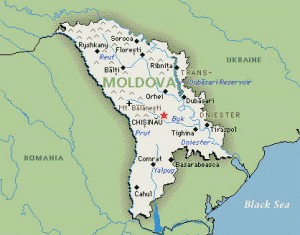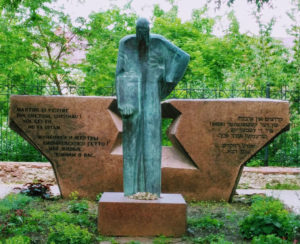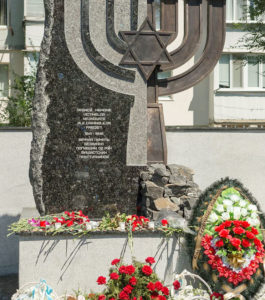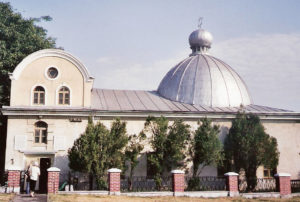 The history of the Jews in Moldova reaches since the 14th century. In the 15th century, Sephardic Jewish merchants began using Bessarabia (a region that today includes Moldova) as a trade route between the Black Sea and Poland. Bessarabia is the region between the Dniestr and Prut rivers. Jews settled in the region, prompting a growth of communities in northern and central Bessarabia. Jewish communities were found in southern Bessarabia in the 16th century. Tiraspol in the Southeast of Moldova, has had a thriving Jewish presence since the 17th century. Soroki in northern Moldovawas first settled in 1657.
The history of the Jews in Moldova reaches since the 14th century. In the 15th century, Sephardic Jewish merchants began using Bessarabia (a region that today includes Moldova) as a trade route between the Black Sea and Poland. Bessarabia is the region between the Dniestr and Prut rivers. Jews settled in the region, prompting a growth of communities in northern and central Bessarabia. Jewish communities were found in southern Bessarabia in the 16th century. Tiraspol in the Southeast of Moldova, has had a thriving Jewish presence since the 17th century. Soroki in northern Moldovawas first settled in 1657.
Jews had been present in all major towns since the end of the 18th century and the beginning of the 19th. Jewish life flourished with 16 Jewish schools and over 2,000 pupils in Chișinău alone. In 1903 Chișinău in Russian Bessarabia had a Jewish population of 50,000. However, later that year there was a major pogrom during the Easter holidays. The pogrom lasted for three days, without the intervention of the police. Over 47 Jews were killed, 92 severely wounded, 500 slightly wounded and over 700 houses destroyed.
 In 1917, after World War I, Bessarabia became part of a territory controlled by the Soviet Union. The Jewish community in the area was given Romanian citizenship and was able to open Jewish day schools. Manifestations of anti-Semitism and violence continued to reveal themselves, despite promises of civic equality for Jews in the Soviet Union. Romania took control of Bessarabia between 1918 and 1940, and Jewish life continued to thrive in the region. Jews automatically received Romanian citizenship in 1918 and were permitted to open Jewish elementary and secondary schools. By 1922, there were approximately 140 Jewish schools in Bessarabia. During this time, there also existed 13 Jewish hospitals and old-age homes. By 1920, the Jewish population in Moldova numbered about 267,000. Although, the numbers of Jewish citizens continued to climb, many communities experienced hostility and anti-Jewish harassment.The 1930s marked the peak of Jewish life in Moldova.
In 1917, after World War I, Bessarabia became part of a territory controlled by the Soviet Union. The Jewish community in the area was given Romanian citizenship and was able to open Jewish day schools. Manifestations of anti-Semitism and violence continued to reveal themselves, despite promises of civic equality for Jews in the Soviet Union. Romania took control of Bessarabia between 1918 and 1940, and Jewish life continued to thrive in the region. Jews automatically received Romanian citizenship in 1918 and were permitted to open Jewish elementary and secondary schools. By 1922, there were approximately 140 Jewish schools in Bessarabia. During this time, there also existed 13 Jewish hospitals and old-age homes. By 1920, the Jewish population in Moldova numbered about 267,000. Although, the numbers of Jewish citizens continued to climb, many communities experienced hostility and anti-Jewish harassment.The 1930s marked the peak of Jewish life in Moldova.
The territory was seized by the Soviet Union in June 1940 under the provisions of the 1939 Nazi-Soviet non-aggression pact. The Soviets promptly sent thousands of Jews suspected of disloyalty to gulags (work camps) or to Siberia. Up to two-thirds of Bessarabian Jews fled before the retreat of the Soviet troops before Germany reconquered Bessarabia on July 23, 1941. Approximately 110,033 Jews from Bessarabia and Bukovina were deported to the Transnistria Governorate, a region which was under Romanian military control during 1941–44. Thousands of Jews died in mass shootings, starvation, disease, deportations, ghettos and concentration camps on Bessarabian and Ukrainian territory. The Jewish community of Kishinev was nearly annihilated, with the Nazis murdering 53,000 out of the 65,000 inhabitants of the city.
 Some of the people who rescued the Jews were: George & Lyuba Benya, and Paramon & Tamara Lozan. The Russian Orthodox priest, George Benya, rescued 26 Jews imprisoned in a warehouse. George threatened the commander of the police that he would organize a public prayer session denouncing his family. The police commander, who was opposed to releasing the Jews, gave in to the priest’s pressure and let them go. Afterwards, the priest and his wife, Lyuba, brought some baked goods to the Jews and accompanied them up to the edge of the village to ensure that no harm would come to them.
Some of the people who rescued the Jews were: George & Lyuba Benya, and Paramon & Tamara Lozan. The Russian Orthodox priest, George Benya, rescued 26 Jews imprisoned in a warehouse. George threatened the commander of the police that he would organize a public prayer session denouncing his family. The police commander, who was opposed to releasing the Jews, gave in to the priest’s pressure and let them go. Afterwards, the priest and his wife, Lyuba, brought some baked goods to the Jews and accompanied them up to the edge of the village to ensure that no harm would come to them.
Paramon Lozan was the principal of a local secondary school where his wife, Tamara , also worked as a teacher. On the eve of the German invasion of the Soviet Union, his wife gave birth to twins. Paramon was told to open his school as a temporary collection point for Jews. The following day, convoys of Jews began to arrive at the school, and when it was completely full, the doors were locked and guards were placed at the door. At night, some of the residents of the town, including Tamara Lozan, secretly brought food to the Jews. Five days later, it was rumoured that the Jews interned in the school building were to be killed. Paramon decided to release the Jews. The Lozans were arrested and Paramon was executed a few days later. His wife, Tamara was released, because her children were only two months old.
 In August 1944, the Russians reoccupied the region. This land became the Moldavian Soviet Socialist Republic with the capital in Kishinev. In 1945-1946 most of the survivors were allowed to return to Moldova. Following the Holocaust, much of the Jewish community of Moldova met with increasing hardships, were forbidden to practice many Jewish traditions, under Communism. After World War II, the number of Jews in Moldavian Soviet Socialist Republic increased significantly, peaking at 98,001 in 1970. During the 1970s and especially late 1980s, many of them emigrated to Israel.
In August 1944, the Russians reoccupied the region. This land became the Moldavian Soviet Socialist Republic with the capital in Kishinev. In 1945-1946 most of the survivors were allowed to return to Moldova. Following the Holocaust, much of the Jewish community of Moldova met with increasing hardships, were forbidden to practice many Jewish traditions, under Communism. After World War II, the number of Jews in Moldavian Soviet Socialist Republic increased significantly, peaking at 98,001 in 1970. During the 1970s and especially late 1980s, many of them emigrated to Israel.
Moldova once had 80 synagogues. In August 2019, Jews in Chisinau reopened the Wooden Synagogue, or the Lemnaria Synagogue in the cellar of the Kedem Jewish Community Centre. The original synagogue was established in 1835 and nationalized by the Soviets in 1940. In 2005, the American Jewish Joint Distribution Committee opened the JCC in the building that once housed the synagogue. The community now has four synagogues. The Jewish Community offers educational activities for the Jewish students. There is one Jewish kindergarten in Chisinau, two Jewish schools and a municipal Jewish library.
 A memorial to Jews who perished in the Holocaust was unveiled on 21 July 2020 in Cahul, Moldova, where a ghetto had been built to house the Jewish population of the district and its environs in 1941-1944. The monument on the site of the former ghetto should guarantee the preservation of painful memories and deep regret about the injustice. The memorial seeks to educate future generations in the spirit of universal human values: faith and dignity, prosperity and equality of nationalities.
A memorial to Jews who perished in the Holocaust was unveiled on 21 July 2020 in Cahul, Moldova, where a ghetto had been built to house the Jewish population of the district and its environs in 1941-1944. The monument on the site of the former ghetto should guarantee the preservation of painful memories and deep regret about the injustice. The memorial seeks to educate future generations in the spirit of universal human values: faith and dignity, prosperity and equality of nationalities.